
15760 Albion, provisional designation 1992 QB1, was the first trans-Neptunian object to be discovered after Pluto and Charon. Measuring about 108–167 kilometres in diameter, it was discovered in 1992 by David C. Jewitt and Jane X. Luu at the Mauna Kea Observatory, Hawaii. After the discovery, they dubbed the object "Smiley" and it was shortly hailed as the tenth planet by the press. It is a "cold" classical Kuiper belt object and gave rise to the name cubewano for this kind of object, after the QB1 portion of its designation. Decoding its provisional designation, "QB1" reveals that it was the 27th object found in the second half of August of that year. As of January 2018, around 2,400 further objects have been found beyond Neptune, a majority of which are classical Kuiper belt objects. It was named after Albion from William Blake's mythology.

(55565) 2002 AW197 is a classical, non-resonant trans-Neptunian object from the Kuiper belt in the outermost region of the Solar System, also known as a cubewano. With a likely diameter of at least 700 kilometers (430 miles), it is approximately tied with 2002 MS4 and 2013 FY27 (to within measurement uncertainties) as the largest unnamed object in the Solar System. It was discovered at Palomar Observatory in 2002.
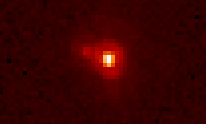
(55637) 2002 UX25 is a trans-Neptunian object that orbits the Sun in the Kuiper belt beyond Neptune. It briefly garnered scientific attention when it was found to have an unexpectedly low density of about 0.82 g/cm3.
(15789) 1993 SC is a trans-Neptunian object of the plutino class. The discovery was made in 1993 at the La Palma Observatory with the Isaac Newton Telescope. It was the second plutino to receive an MPC number.

79360 Sila–Nunam, provisional designation 1997 CS29, is a cold classical Kuiper belt object (cubewano) and binary system made up of components of almost equal size, called Sila and Nunam, orbiting beyond Neptune in the Solar System. The name of the system is the combined names of the two bodies, Sila and Nunam.
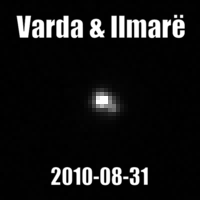
174567 Varda (provisional designation 2003 MW12) is a binary trans-Neptunian planetoid of the resonant hot classical population of the Kuiper belt, located in the outermost region of the Solar System. Its moon, Ilmarë, was discovered in 2009.
(24835) 1995 SM55, provisional designation 1995 SM55, is a trans-Neptunian object and member of the Haumea family that resides in the Kuiper belt, located in the outermost region of the Solar System. It was discovered on 19 September 1995, by American astronomer Nichole Danzl of the Spacewatch program at Kitt Peak National Observatory near Tucson, Arizona, in the United States. It measures approximately 200 kilometers in diameter and was the second-brightest known object in the Kuiper belt, after Pluto, until 1996 TO66 was discovered.

Salacia is a large trans-Neptunian object in the Kuiper belt, approximately 850 km (530 mi) in diameter. It was discovered on 22 September 2004, by American astronomers Henry Roe, Michael Brown and Kristina Barkume at the Palomar Observatory in California, United States. Salacia orbits the Sun at an average distance that is slightly greater than that of Pluto. It was named after the Roman goddess Salacia and has a single known moon, Actaea.
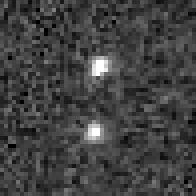
88611 Teharonhiawako, or (88611) Teharonhiawako–Sawiskera as a binary, is a trans-Neptunian object and a member of the cold classical Kuiper belt, measuring about 220 km in diameter. It is a binary object, with a large companion named Sawiskera, which at 126 km in diameter is about two-thirds the size of its primary.
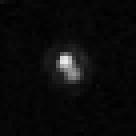
65489 Ceto, as a binary also (65489) Ceto/Phorcys, is a binary trans-Neptunian object (TNO) discovered on March 22, 2003, by Chad A. Trujillo and Michael Brown at Palomar. It is named after the sea goddess Ceto from Greek mythology. It came to perihelion in 1989.

66652 Borasisi, or as a binary (66652) Borasisi-Pabu, is a binary classical Kuiper belt object. It was discovered in September 1999 by Chad Trujillo, Jane X. Luu and David C. Jewitt and identified as a binary in 2003 by K. Noll and colleagues using the Hubble Space Telescope.

Actaea, officially (120347)Salacia I Actaea, is a natural satellite of the classical Kuiper belt planetoid 120347 Salacia. Its diameter is estimated 300 km (190 mi), which is approximately one-third the diameter of Salacia; thus, Salacia and Actaea are viewed by William Grundy et al. to be a binary system. Assuming that the following size estimates are correct, Actaea is about the sixth-biggest known moon of a trans-Neptunian object, after Charon (1212 km), Dysnomia (700 km), Vanth (443 km), Ilmarë (326 km) and Hiʻiaka (320 km), but possibly also Hiisi.

148780 Altjira is a binary classical Kuiper belt object (cubewano). The secondary, S/2007 (148780) 1, is large compared to the primary, 140 kilometres (87 mi) vs. 160 kilometres (99 mi). The Altjiran lightcurve is quite flat (Δmag<0.10), which is indicative of a "quasi-spherical body with a homogeneous surface".

(612095) 1999 OJ4, prov. designation: 1999 OJ4, is a trans-Neptunian object and binary system from the classical Kuiper belt, located in the outermost region of the Solar System. The bright cubewano belongs to the cold population and measures approximately 75 kilometers (47 miles) in diameter. It was first observed at Mauna Kea Observatory on 18 July 1999. Discovered in 2005, its minor-planet moon is just 3 kilometers smaller than its primary and has an orbital period of 84 days.
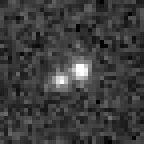
385446 Manwë, or (385446) Manwë–Thorondor, is a binary resonant Kuiper belt object in a 4:7 mean-motion resonance with Neptune. It was discovered on 25 August 2003, by American astronomer Marc Buie at Cerro Tololo Observatory in northern Chile. A study of Manwë's light curve in 2019 suggests that it may be a contact binary object.
(508869) 2002 VT130, provisional designation 2002 VT130, is a trans-Neptunian object and binary system from the classical Kuiper belt, located in the outermost region of the Solar System. It was discovered by American astronomer Marc Buie at Kitt Peak Observatory on 7 November 2002. The primary measures approximately 324 kilometers (201 miles) in diameter.

(524366) 2001 XR254, provisional designation 2001 XR254, is a trans-Neptunian object and binary system from the classical Kuiper belt, located in the outermost region of the Solar System. The cubewano belongs to the cold population and measures approximately 171 kilometers (110 miles). It was first observed on 10 December 2001, by astronomers at the Mauna Kea Observatory, Hawaii. Its 140-kilometer sized companion was discovered by the Hubble Space Telescope in June 2006.

(275809) 2001 QY297 is a trans-Neptunian object from the classical Kuiper belt, located in the outermost region of the Solar System. The binary classical Kuiper belt object belongs to the cold population.
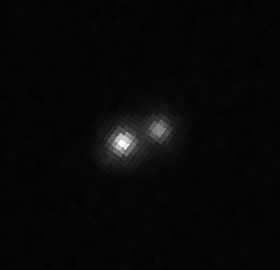
469705 ǂKá̦gára (provisional designation 2005 EF298) is a trans-Neptunian object and binary system of the core Kuiper belt, located in the outermost region of the Solar System. It was discovered on 11 March 2005 by American astronomer Marc Buie at the Kitt Peak Observatory in Arizona. The primary body measures around 140 kilometers (90 miles) in diameter. Its 120-kilometer (75-mile) companion ǃHãunu was discovered with the Hubble Space Telescope in 2009. The ǂKá̦gára–ǃHãunu system is currently undergoing mutual occultation and eclipsing events in which one body casts a shadow on or obstructs the view of the other as seen from Earth.
2011 JY31 is a binary trans-Neptunian object from the Kuiper belt, located in the outermost region of the Solar System. It was discovered on 4 May 2011, by a team of astronomers using one of the Magellan Telescopes in Chile during the New Horizons KBO Search for a potential flyby target for the New Horizons spacecraft. Distant observations by New Horizons from September 2018 revealed its binary nature, showing two 50 km (31 mi)-wide components in a tight, mutual orbit 200 km (120 mi) apart. The discovery adds support to streaming instability as the dominant mechanism in the formation of tight and contact binary planetesimals such as 486958 Arrokoth, which appear to be prevalent in the cold classical Kuiper belt population.


















